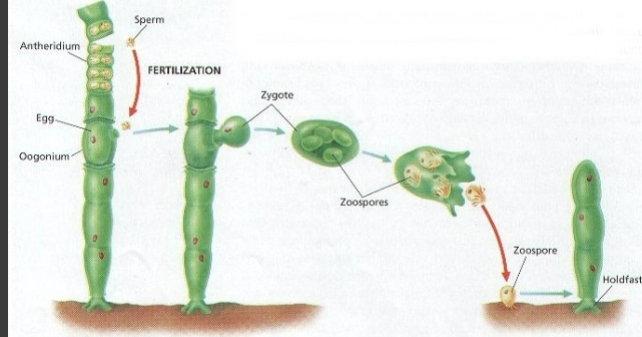Lecture 2 + 4 (multicellular algae)- Marine Bio
1/28
There's no tags or description
Looks like no tags are added yet.
Name | Mastery | Learn | Test | Matching | Spaced |
|---|
No study sessions yet.
29 Terms
hydrologic cycle
the movement of water through the biosphere like currents
Hadley cells
warm air currents meet at equator to rise and cool down then gradually sink until they pick up heat again then repeated
how does the ocean influence through heat?
sunlight is absorbed by the ocean
ocean loses heat through evaporation (latent heat release)
ocean loses heat by sending out infrared radiation that is absorbed by water vapor to further heat
winds drive ocean currents to carry heat from tropics
uneven distribution of temps?
tropics warm bc they receive lots of sunlight
poles cool bc receive less sunlight
transport influenced by other patterns like land mass
chemical composition
seawater has avg salinity of 35%
thermocline
rapid temp change over short depth change
start of thermo is epilimnion and everything below is hypolimnion
upwelling
movement of deep, cold, and nutrient-rich water to the surface
coral reefs
50% of net primary production occurs there bc of zooxanthellae
9 times as much carbon per unit area per year than the ocean
waves
driven by winds and currents
rougher the water the easier for the wind to transfer its energy
ocean tides
cyclic rise and fall of seawater caused by variations in gravitational attraction btw earth, moon, and sun
spring tides
sun and moon pull together = highest tides
neap tides
sun and moon not pulling together = not very high tides
diurnal tides
1 high and 1 low per day
semi-diurnal tides
2 high and 2 low per day
heights do vary
mixed tides
very high then very low, then semi high then semi low, then reset
composition of sea floor
1) sediments
2) volcanic ash
3) biogenic sediments
4) hydrothermal sediments
5) mechanical fracturing
6) weak acid fracturing
multicellular algae
thallus
seaweeds
filamentous algae with slender, rod-shaped thallus arranged in twos joined end-to-end
holdfasts
specialized structures in some filamentous algae that attaches the algae so it can grow toward sunlight at the surface
pneumatocysts
gas-filled blader in seaweeds
algae vs seaweeds
algae - holdfast + blade + stipe
sea - leaves + rhizomes + flowering + roots
Enteromorpha
filamentous green algae

Macrocystis
bladder kelp, large brown algae have pneumatocysts
among the largest multicellular algae

algae phyla
1) based on color
2) type of chlorophyll
3) form of food-storage substance
green algae (Chlorophyta)
-Spirogyra, Ulva, Chlamydomonas, Enteromorpha, Caulerpa
-chlorophyll a, b, and carotenoids (yellow and orange pigments)
-store food as starch
-cell=cellulose
-some add CaCO3
-freshwater, moist surfaces, or marine environments
-some have whip-like flagella for movement
brown algae (Phaeophyta)
-Laminaria, Fucus, Sargassum
-chlorophyll a, c, and fucoxanthin (brown pigment)
-most grow in cooler marine environments
-includes kelp and seaweeds
-store food as laminarin (type of carbohydrate)
red algae (Rhodophyta)
-Agardhiella, Spongomorpha
-usually warm marine environments
-chlorophyll a and phycobilin (red pigments)
-store food as starch
-cell walls contain cellulose and agar
-some contain carrageenan in their cell walls used for gelatin capsules and some cheeses
reproduction in multicellular algae

Ulva reproduction
